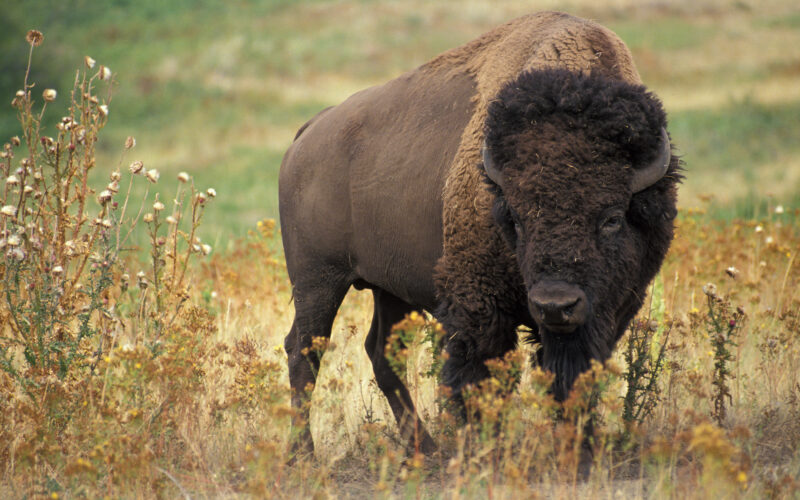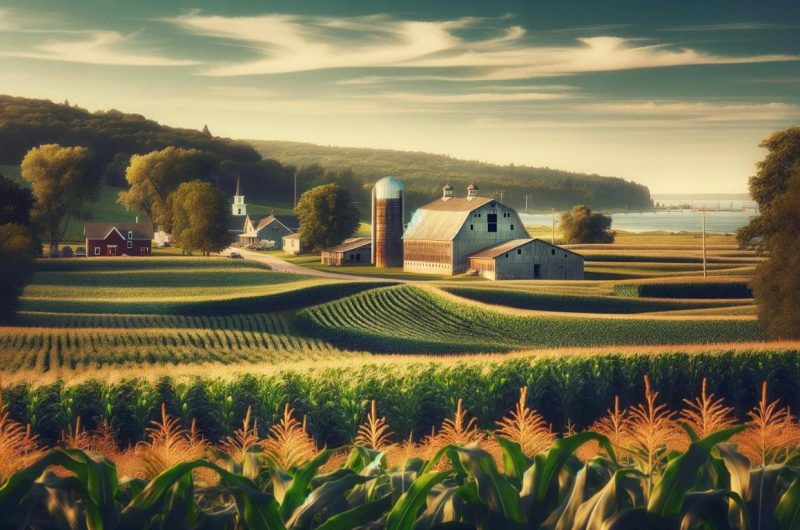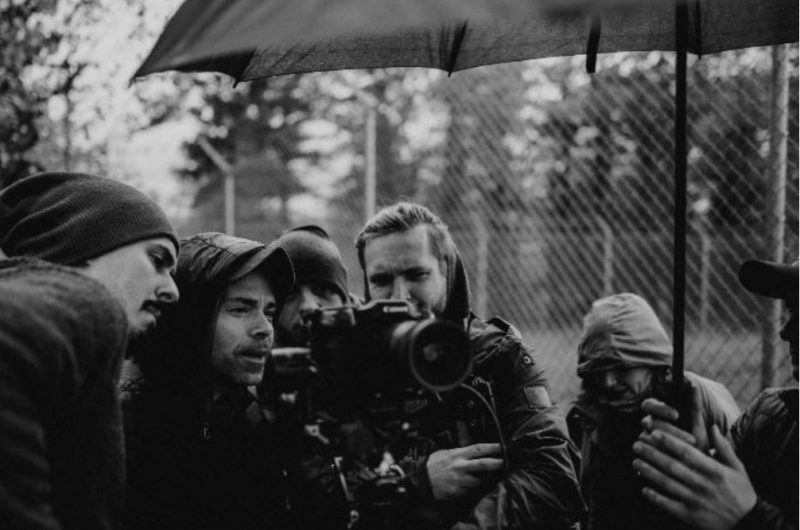Buffalo in Michigan’s Upper Peninsula

Studies dealing with the American buffalo–or more accurately bison–have traced their range far from their traditional homeland on the Great Plains. They ranged from the foothills of the Rocky Mountains to the Appalachians and from Great Slave Lake in the Northwestern Territories of Canada to southern Texas.
In 1660, their eastern range was from Great Slave Lake through central Minnesota, down through southwestern Wisconsin, along the southern edge of the Great Lakes and eastward to the Appalachians. However these and other studies do not include their range into Lower Michigan or the Upper Peninsula. Today, data have been uncovered that add to the range of at least a small number of buffalo.
The first buffalo-related information comes from the pen of Pierre Esprit Radisson (c1640-1710). He was a French fur trader and explorer who worked with his partner and brother-in-law, Médard Chouart, Sieur des Groseilliers (1618-1696). In August 1659, the two men led a party and journeyed around Lake Superior gathering furs and investigating the future possibilities of trading in the region.1
They spent the winter of 1659-1660 first just south of Lake Superior in Wisconsin and then at an Ojibwa village on the shore. By August 24, 1660 they had returned to Québec City with their furs and accounts of their journey.
What interests us is that Radisson on his journey writes of the “buff” or buffalo in the Upper Peninsula of Michigan, possibly along the south shoreline or near Sault Ste. Marie. The term buffe or wyld ox first appeared in English in Richard Huloet’s Abecedarium Anglico-Latinum published in 1552.2
So Radisson is accurately writing about and describing what we know as the buffalo or American bison. He recounts: “As for the Buff, it is a furious animal. One must have a care of him, for every year he kills some Nadouseserons (Sioux/Dakota living in central Minnesota). He comes for the most part in the plains and meadows; he feeds like an ox.” Then Radisson continues with a more detailed description of the animal:
The horns of Buffs are as those of an ox, but not so long, but bigger, and of a blackish color, he has a very long hairy tail; he is reddish, his hair frizzes and very fine. All the parts of his body much [like] onto an ox. The biggest are bigger than any ox whatsoever. Those are to be found about the lake of the Stinkings [Green Bay] and towards the North of the same. They come not to the upper lake [Lake Superior] but by chance. It is a pleasure to find the place of their abode, for they turn round about compassing two or three acres of land, beating the snow with their feet, and coming to the center they lie down and rise again to eat the bows of trees that they can reach. They go not out of their circle that they have made until hunger compels them.3
First we must discount Radisson’s written English. He was a Frenchman with a rough knowledge of the English language. However his account is of the bison and from the way he writes he has seen the animals north of Green Bay. He further notes that they are not native to the Lake Superior shoreline, but come “by chance.” What has occurred is that some bison broke from the herd in west-central Minnesota or southwestern Wisconsin and traveled through the forests, finding pasture in open fields and grasslands.
The next account of buffalo nearing Lake Superior comes from Jonathan Carver (1710-1780) who was a colonial American military officer, explorer and writer. In 1766-1767 he explored Wisconsin, Iowa and Minnesota along the upper Mississippi River. He wrote that in the area between Lake Pepin and Eau Claire in western Wisconsin was covered with grasslands and afforded pasturage for buffalo that were there in plentiful numbers.
When seen at a distance they seemed to be like cattle grazing and he saw a drove of a hundred or more shading themselves from the noon sun under trees. Several were killed and they weighed 1,500 pounds but if properly fattened Carver felt that they could weight as much as 3,000 pounds. He concluded, “Their meat is very good and tender, and their fat is but a little inferior to butter, their [bone] marrow is equal to the best of butter.”
Carver also noted that Indians made bottles out of buffalo bladders and skins. Finally, he wrote that in the vicinity of the St. Croix and Chippewa Rivers in northwest Wisconsin, near the Upper Peninsula border, “One thing well worth notice in these parts is the wool of the buffalo which is long and fine and can certainly be manufactured into cloth.”4 In this latter statement either there were buffalo in the area that were hunted and their woolly hide was used or the hide was traded.
The final account buffalo in the north country comes from the metis historian, interpreter and legislator in Minnesota territory, William W. Warren (1825-1853). He was one of the first historians to understand and utilize oral tradition or interviews, which he gathered from Ojibwa people.
Prior to his death he had interviewed Ojibwa whose histories allowed him to write:
The more hardy and adventurous hunted on the lake [Superior] shore opposite their village [at La Pointe, Wisconsin], which was overrun with moose, bear, elk, and deer. The buffalo, also, are said in those days [c1820s-1830s] to have ranged within a half a day’s march from the lake [Superior] shore, on the barrens stretching towards the headwaters of the St. Croix River.5
In conclusion, it is of interest to note that these accounts developed in 1660, 1766, and 1830s approximately a century apart. Also by 1800 bison were no longer sighted in the eastern United States. However from these accounts we can safely say that some bison broke from the herd and found their way into the Upper Peninsula by 1660.
Unfortunately our documentation concerning the range of these animals is limited. They certainly could have entered the heart and eastern end of Upper Peninsula at later dates but no one left an account. Their appearance in the UP is similar to wild cats that are showing up today having traveled distances from their homes in the west.
FOOTNOTES
1Grace Lee Nute. Caesars of the Wilderness: Médard, Sieur des Groseilliers and Pierre Esprit Radisson. St. Paul: Minnesota Historical Society Press, 1978 and Harold A. Innis. The Fur Trade in Canada: An Introduction to Canadian Economic History. Toronto: University of Toronto Press, 1930.
2Richard Huloet. Abecedarium Anglico-Latinum. London: Gul. Riddel, 1552, “Buff.”
3“Radisson’s Third Journey,” in Louise P. Kellogg, editor. Early Narratives of the Northwest, 1634-1699. New York: Charles Scribner’s Sons, 1917, p. 52.
4Jonathan Carver. The Journals of Jonathan Carver and Related Documents, 1766-1770. Edited by John Parker. St. Paul: Minnesota Historical Society Press, 1976, pp. 126-127, 129, 141.
5William W. Warren. The History of the Ojibway People. St. Paul: Minnesota Historical Society Press, 1885, p. 97.






Very interesting
He needs to follow up with Gerry Olsen from Traverse City(Olsens Market) who raised and sold buffalo meet. He had a herd of buffalo in the UP at one time.
Traverse City is not part of the UP.
Bison not Buffalo!!
Who cares
Buffalo were also seen in SW Michigan in the Burr Oak openings.
Clyde’s sells bison burgers
They sure do, was just there on Friday for the first time.
Thanks for the article, I always have loved Michigan history.
I Raised Buffalo had a small gentleman heard in Grand Blanc Michigan ..I live now on Drummond Island and I am looking for some young calves bison / buffalo to start up a herd here on the island if anyone knows of individuals in my area that sell let me know.
There is a small herd in the west end of the UP,near the town of Ewen.
I Raised Buffalo had a small gentleman heard in Grand Blanc Michigan ..I live now on Drummond Island and I am looking for some young calves bison / buffalo to start up a herd here on the island if anyone knows of individuals in my area that sell let me know.
Rather than being a slight possibility or an untested theory. It seems to me that by virtue of these exerpts. Occupation of American Bison in the U.P. circa 1660’s – 1830’s must now be viewed only in the light of factual historic record!
Research of this calibur is tedious, time consuming and exhausting. Never the less. This sort of exploration deep into the labyrinth of the historical record is vital to building a solid, supporting, factual narrative recounting the natural ebbs and flows of the North American continent. The true value of these sort of works. Can not be fully tallied for decades, centuries and perhaps millenia…
Bravo! Job Well Done!!
The work here speaks to other additional factual information. Information of what is rapidly evolving into a far greater world wide importance. This thesis unassumingly has also produced factual data supporting sparcely distributed historic documentation that Wisconsin was a very well known winter haven of the American Bison. A refueling hub per se.
Here we also uncover more documents proving Green Bay, WI. is the fabled “LAKE OF THE STINKINGS”! This is neither funny or laughable! It is the SAD! SAD! SIMPLE UNAVOIDABLE TRUTH! GREEN BAY, WI. IS AND HAS BEEN RENOWNED FOR ITS STINKINGS. This goes far back into prehistory… The “Stinkings” is a phenomena which spreads across Green Bay with a “broad paintbrush”. For reasons that have yet been determined. “THE STINKINGS” congregate and are at their most noxious in exactly these same 2 areas: 1201 Saint Agnes Drive and at the swamp at the end of 3030 Currey Lane. The pungent overpowering ripe “Stinkings” at these 2 locations not only induce vomiting in humans and animals but lead to many misreported deaths.